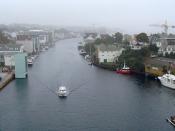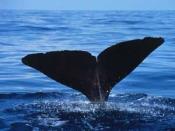Throughout the decades of time, humans have looked to animals for energy, clothing, and food. As time went on, many such animals were hunted for a great profit. This holds true for the whaling industry. It is recorded that whalers had killed so many blue, bowhead, humpback, and right whales that these species face the threat of extinction. In 1982, the International Whaling Commission voted for a moratorium on commercial whaling. They also created the Indian and Southern Ocean Whale Sanctuary which banned commercial whaling in certain areas of the ocean. Despite these restrictions, Japan, Norway, and parts of Russia continue to hunt these large mammals of the sea.
People began to hunt whales in prehistoric times. At first, the early humans simply killed and ate whales that had become stranded on beaches. Among the earliest whalers to seek out and kill whales in the ocean is the region of Norway.
"Norwegian rock carvings about 4,000 years old show a variety of whaling scenes"1. The earliest written record of Norwegian whaling dates from about 890 A.D.
It was the Basque people of southern France and northern Spain that established the first large whaling industry in Europe. At first the Basque hunted baleen whales in the Bay of Biscay near the shore from small open boats. The whalers maneuvered their boats close enough to a whale so one of them could harpoon it. A rope connected the harpoon to the boat, and in time, the whale exhausted. The whalers then killed it with sharp lances and towed the body to shore for processing.
In the 1200's the Basque technologies advanced. The Basque began to equip large sailing ships for whaling voyages. Each ship carried several small whaleboats from which the whalers set out to kill whales "after killing a whale, the...
![King [Haakon] and Queen [Maud] of Norway and [Crown] Prince Olaf (LOC)](https://s.writework.com/uploads/11/119823/king-haakon-and-queen-maud-norway-and-crown-prince-olaf-loc-thumb.jpg)

